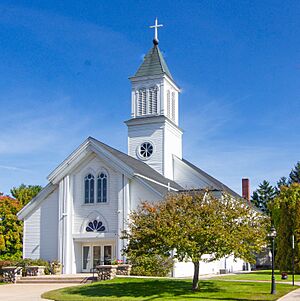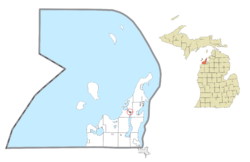Lake Leelanau, Michigan facts for kids
Quick facts for kids
Lake Leelanau, Michigan
|
|
|---|---|

St. Mary of the Assumption Catholic Church in Lake Leelanau
|
|

Location within Leelanau County
|
|
| Country | |
| State | |
| County | |
| Township | Leland and Suttons Bay |
| Area | |
| • Total | 0.28 sq mi (0.73 km2) |
| • Land | 0.26 sq mi (0.66 km2) |
| • Water | 0.03 sq mi (0.07 km2) |
| Elevation | 617 ft (188 m) |
| Population
(2020)
|
|
| • Total | 229 |
| • Density | 898.04/sq mi (346.83/km2) |
| Time zone | UTC-5 (Eastern (EST)) |
| • Summer (DST) | UTC-4 (EDT) |
| ZIP Code |
49653
|
| Area code(s) | 231 |
| GNIS feature ID | 620195 |
| FIPS code | 26-44760 |
Lake Leelanau is a small community in Leelanau County, Michigan. It is an unincorporated community, which means it doesn't have its own local government like a city or town. It's also a census-designated place (CDP), which is an area the government defines for gathering population data.
This community is located right next to the beautiful lake of the same name. In 2020, about 229 people lived here. Lake Leelanau sits along a road called M-204, at a narrow spot that divides the north and south parts of the lake. The community is split between two larger areas called Leland Township and Suttons Bay Township.
Contents
History of Lake Leelanau
Early Inhabitants and Names
Long ago, the Native Americans lived in this area. They had special names for the land and the lake. They called the narrow body of water ke-ski-bi-ag. This name means "narrow body of water." They called the lake itself lee-lan-au, which means "delight of life."
Later, a man named Henry Rowe Schoolcraft helped formally name the county. He was an Indian agent, which means he worked for the government with Native American tribes. He used "Leelinau" as a character in his stories.
Jane Johnston Schoolcraft's Influence
It's now known that "Leelinau" was first used by Henry Schoolcraft's wife, Jane Johnston Schoolcraft. She used it as a pen name (a fake name used by a writer) in a family magazine they wrote together in the 1820s. Jane Johnston was part Ojibwa (a Native American tribe) and part Scots-Irish. She wrote in both the Ojibwe language and English.
Even though her writings weren't officially published during her lifetime, Jane Johnston Schoolcraft is now recognized as a very important writer. She is known as the first Native American literary writer and the first known Indian woman writer. She was also the first known poet to write poems in a Native American language. In 2008, she was honored by being added to the Michigan Women's Hall of Fame.
French Settlers and New Names
In the mid-1800s, French settlers started arriving from Canada. Because of the narrow part of the lake, they began calling the settlement "Le Naro." This name came from the French word for "the narrows." These narrows connect the North and South parts of Lake Leelanau. Some early settlers also called the river and the lake "Carp Lake." Some local people still use this name today.
Changes to the Lake and Land
In 1854, a dam was built on the Leland River. This dam raised the water level by about 12 feet (3.7 meters). This made the lakes much bigger than they were before.
The Schaub family arrived in 1855 and started farming. They planted the first vineyard (a place where grapes are grown for wine) in Leelanau County. Wine from their vineyard was sold locally and sent to other places like Detroit and Ohio.
In 1867, a fur trader named Andre de Beloit tried to find oil by drilling. He didn't find oil, but he hit an artesian spring. This is a natural spring where water flows up from the ground without needing a pump. This spring still flows today at a nearby resort called Fountain Point.
Community Names and Schools
On May 10, 1871, the first post office was opened. It was called "Provemont." People believe this name came from the word "improvement." However, on March 31, 1924, the village and post office officially changed their name to "Lake Leelanau."
In 1887, a Catholic school was built in the community. It was named St. Mary of the Assumption. The first school building was made of wood and had two stories. It later burned down. A new brick building was built in 1928 next to where the old one stood.
Geography of Lake Leelanau
Lake Leelanau is located in the northeastern part of Leelanau County. Most of the community is on the west side of the narrow part of the lake. A smaller part is on the east side. The state highway M-204 goes through the middle of the community. This highway leads east about 4 miles (6.4 km) to Suttons Bay on Grand Traverse Bay. It also leads west about 3 miles (4.8 km) to M-22, which is near the shore of Lake Michigan.
The Lake Leelanau CDP (the area defined for census data) covers about 0.28 square miles (0.73 square kilometers). Most of this area is land, but a small part is water. The water from North Lake Leelanau flows into Lake Michigan about 4 miles (6.4 km) to the northwest, near the community of Leland.
Population Data
| Historical population | |||
|---|---|---|---|
| Census | Pop. | %± | |
| 2010 | 253 | — | |
| 2020 | 229 | −9.5% | |
| U.S. Decennial Census | |||
According to the 2020 census, the population of Lake Leelanau was 229 people.
Community Life
When summer arrives in the Leelanau Peninsula, many people come to the Lake Leelanau area for vacations. They enjoy the beautiful scenery, boating, and fishing. There are also restaurants and shops along the narrow part of the lake. This peaceful way of life has been written about in essays by Kathleen Stocking.
From Lake Leelanau, visitors can easily take short trips to other nearby towns. These include Leland, Suttons Bay, Glen Arbor, Northport, and the famous Sleeping Bear Dunes National Lakeshore. The soil in the area is also good for growing fruit, so there are several orchards and wineries. These places offer "agri-tourism," where people can visit farms and learn about local agriculture.
The community has also worked hard to protect the area from too much development. They want to keep the natural beauty and have supported efforts to create a nature conservancy.
Climate in Lake Leelanau
The weather in Lake Leelanau has big differences between seasons. Summers are warm to hot and often humid. Winters are cold, and sometimes very cold. This type of weather is called a humid continental climate.
See also
 In Spanish: Lake Leelanau para niños
In Spanish: Lake Leelanau para niños



